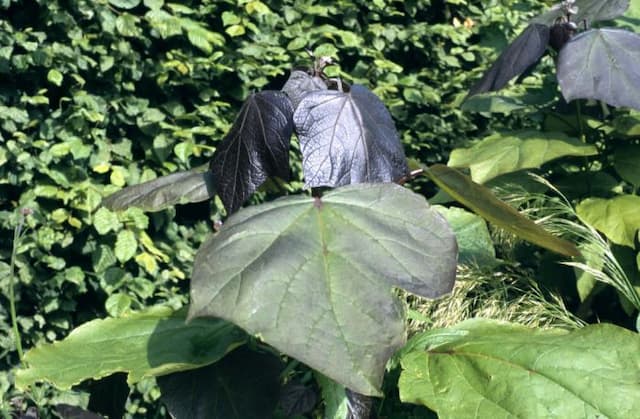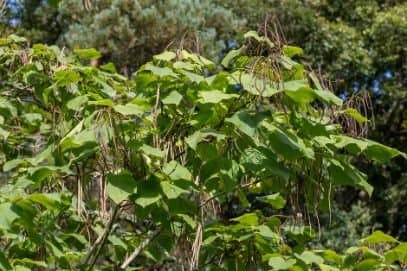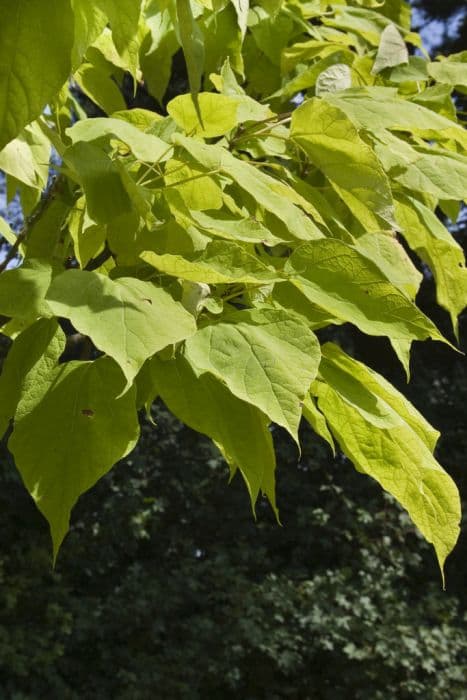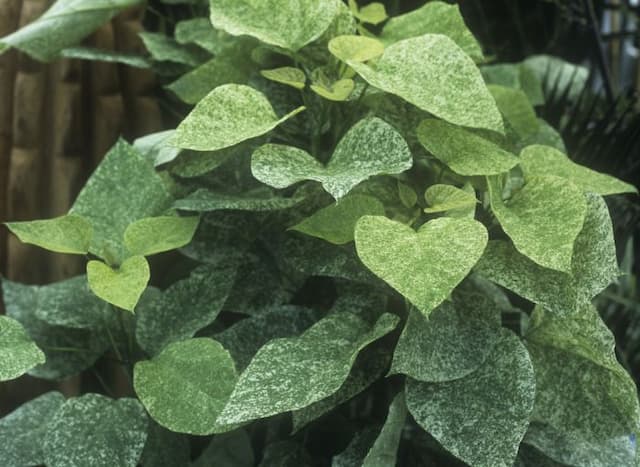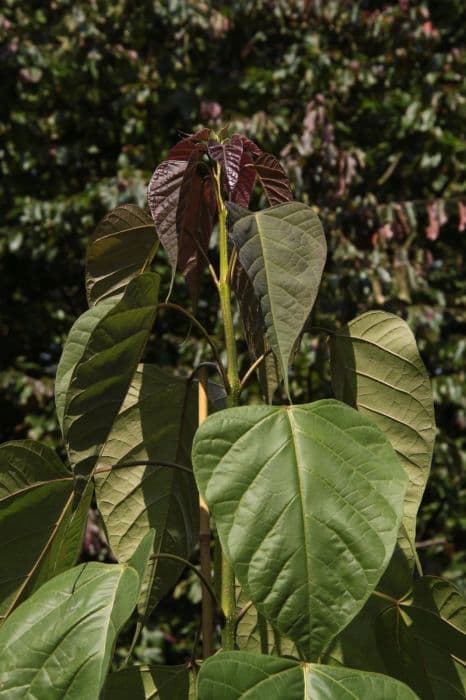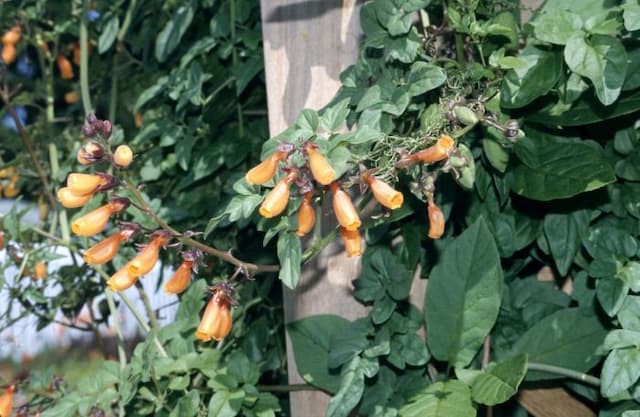Mexican Blood Trumpet Distictis buccinatoria

ABOUT
The common name of Distictis buccinatoria is the blood-red trumpet vine. This plant is notable for its vibrant flowers that trumpet in shape, featuring an intense red hue with a yellow throat, which make them particularly striking and attractive to hummingbirds and other pollinators. The blood-red trumpet vine has glossy green leaves that are evergreen in warmer climates, giving it a lush appearance year-round. The leaves are typically compound, with each leaflet being oval to lance-shaped, adding to the fullness of the foliage. This plant is a vigorous climber, often found adorning walls, trellises, or fences with its enthusiastic growth.
About this plant
 Names
NamesFamily
Bignoniaceae
Synonyms
Blood Vine, Mexican Blood Trumpet, Red Trumpet Vine, Blood-Red Trumpet Vine
Common names
Distictis buccinatoria.
 Toxicity
ToxicityTo humans
The common name for Distictis buccinatoria is the Mexican blood trumpet. This plant is not typically known for being poisonous to humans. However, like many plants, it may cause a reaction in some people if ingested or if the sap comes into contact with skin. Such reactions are usually mild and can include gastrointestinal upset or skin irritation. If any part of the plant is ingested and symptoms occur, seek medical attention.
To pets
The Mexican blood trumpet is not commonly listed as a toxic plant to pets such as dogs and cats. However, as pets can have a variety of reactions to plants that are not universally toxic, it is still wise to prevent pets from ingesting this plant. If a pet does consume any part of the Mexican blood trumpet, watch for signs of gastrointestinal upset or distress, and consult with a veterinarian if symptoms persist or worsen.
 Characteristics
CharacteristicsLife cycle
Perennials
Foliage type
Evergreen
Color of leaves
Green
Flower color
Red
Height
30 feet [9 meters]
Spread
30 feet [9 meters]
Plant type
Climber
Hardiness zones
9
Native area
Mexico
Benefits
 General Benefits
General Benefits- Fast Growth: Distictis buccinatoria, commonly known as the Blood Red Trumpet Vine, is a rapidly growing plant, which allows for quick coverage of walls, fences, and trellises.
- Ornamental Appeal: The plant produces vibrant red and orange trumpet-shaped flowers, which add a splash of color to gardens and landscapes.
- Drought Tolerance: Once established, the Blood Red Trumpet Vine has a degree of tolerance to drought, making it suitable for xeriscaping or low-water gardens.
- Wildlife Attraction: The blossoms of the plant are known to attract hummingbirds, bees, and other pollinators, thus aiding in the pollination of gardens and ecosystems.
- Privacy Screen: Due to its dense foliage, the vine can be used to create a natural privacy screen, providing seclusion for outdoor spaces.
- Shade Provider: When grown over arbors or pergolas, the Blood Red Trumpet Vine offers shade and cooler temperatures beneath its canopy.
- Erosion Control: The plant's robust rooting system can help stabilize slopes and prevent soil erosion in landscaped areas.
 Medical Properties
Medical PropertiesThis plant is not used for medical purposes.
 Air-purifying Qualities
Air-purifying QualitiesThis plant is not specifically known for air purifying qualities.
 Other Uses
Other Uses- As a natural dye: The blood-red trumpet vine can be used to extract a dye for fabric or other decorative purposes, utilizing its vibrant flowers.
- Instrument crafting: The vine's sturdy stems can be fashioned into parts of musical instruments where wood is traditionally used.
- Privacy screens: When grown densely, the blood-red trumpet vine can create a lush and vibrant privacy screen for gardens and patios.
- Erosion control: Planting this vine on slopes can help reduce soil erosion due to its hardy root system.
- Sustainable art material: Trimmed branches and vines can be used in weaving or as a component in eco-friendly sculptures.
- Sound barrier: A thick growth of these vines can help diffuse and reduce the noise pollution in urban gardens.
- Shade provider: Its ample foliage and widespread growth habit offer a natural sunshade for smaller plants or seating areas.
- Culinary garnish: Though not commonly consumed, the bright flowers could serve as an ornamental garnish for special dishes.
- Living archways: When trained over arches or pergolas, the vine creates a striking natural architectural feature.
- Children's outdoor play areas: The vine can be shaped to create tunnels or secret garden spaces for imaginative outdoor play.
Interesting Facts
 Feng Shui
Feng ShuiThe Blood Red Trumpet Vine is not used in Feng Shui practice.
 Zodiac Sign Compitability
Zodiac Sign CompitabilityThe Blood Red Trumpet Vine is not used in astrology practice.
 Plant Symbolism
Plant Symbolism- Strength: The robust growth and sturdy nature of the Blood Red Trumpet Vine are often associated with strength and endurance.
- Passion: The vivid red flowers of the Blood Red Trumpet Vine symbolize intense emotions and passion, representing deep feelings and enthusiasm.
- Vibrancy: The vibrant colors and lively appearance of the Blood Red Trumpet Vine represent liveliness and high energy, denoting a zest for life.
- Attraction: The Blood Red Trumpet Vine's flamboyant blooms are magnets for hummingbirds and butterflies, symbolizing attraction and the power to draw in what one desires.
- Growth: With its fast-growing habit, the Blood Red Trumpet Vine symbolizes quick development and the idea of flourishing in one's environment.
 Water
WaterThe Blood Red Trumpet Vine should be watered deeply once a week, providing enough water so that it reaches the deep roots. In hot, dry periods, watering may need to increase to twice a week, ensuring that each time you provide about 1 to 1.5 gallons of water for each plant. During the winter months or cooler weather, you can reduce the watering frequency as the plant will require less moisture. Avoid over-watering which can lead to root rot, and ensure the soil is well-drained.
 Light
LightThe Blood Red Trumpet Vine thrives best in full sun conditions. It should be planted in a location where it receives at least 6 to 8 hours of direct sunlight daily. Partial shade is also tolerated, but the vine may produce fewer flowers if it doesn't get enough light. The ideal spot is against a sunny wall or fence where it can also receive support for its climbing habit.
 Temperature
TemperatureThe Blood Red Trumpet Vine is hardy and can tolerate a wide range of temperatures, but it performs best in areas where the temperature stays between 50°F and 90°F. It can survive minimum temperatures down to about 20°F and maximum temperatures well above 100°F. To encourage optimal growth and flowering, maintain temperatures within the ideal range whenever possible.
 Pruning
PruningPruning the Blood Red Trumpet Vine is necessary to maintain its shape, size, and to encourage flowering. Prune in late winter or early spring before new growth starts. Remove any dead or damaged branches and cut back up to one-third of the older stems to promote fresh growth. The best time for heavy pruning is after the last frost, as new buds are formed on new wood.
 Cleaning
CleaningAs needed
 Soil
SoilThe Red Trumpet Vine thrives in well-draining, fertile soil with a pH ranging from slightly acidic to neutral (pH 6.0 to 7.0). A mix of loam, compost, and coarse sand or perlite is ideal, which will allow for good aeration and adequate moisture retention while avoiding waterlogging.
 Repotting
RepottingThe Red Trumpet Vine does not require frequent repotting and can suffice with being repotted every 2 to 3 years, depending upon the growth rate and pot size. Repotting is best done during the spring season.
 Humidity & Misting
Humidity & MistingThe Red Trumpet Vine prefers moderate to high humidity levels. However, it is quite adaptable and can tolerate a wide range of humidity conditions provided that it has good air circulation.
 Suitable locations
Suitable locationsIndoor
Ensure bright light, prune to manage size.
Outdoor
Provide full sun, sturdy support for climbing.
Hardiness zone
9-11 USDA.
 Life cycle
Life cycleThe life of the Blood Red Trumpet Vine or Distictis buccinatoria begins with seed germination, which requires warm temperatures and damp soil conditions. Once germinated, the seedling stage involves developing a root system and initial leaves for photosynthesis. As the plant enters the vegetative growth stage, it vigorously produces more leaves and stems, utilizing tendrils to climb structures for support. During the flowering stage, the vine produces vibrant red, trumpet-shaped flowers that attract pollinators such as hummingbirds and bees, leading to pollination and subsequent seed formation. After pollination, the plant develops seed pods, which when matured, open to release seeds, and the cycle potentially begins anew. Throughout its life, the Blood Red Trumpet Vine may undergo periods of pruning and maintenance by gardeners, which is crucial for its management and health, although this is not a natural stage of its life cycle.
 Propogation
PropogationPropogation time
Spring-Early Summer
The most popular method of propagating the Blood Red Trumpet Vine (Distictis buccinatoria) is through semi-hardwood cuttings. This is usually done during the summer when growth is vigorous. To propagate, a cutting of about 4 to 6 inches (10 to 15 centimeters) is taken from a healthy, non-flowering branch, making sure it includes several sets of leaves. The bottom leaves are removed and the cut end is dipped in rooting hormone to stimulate root development. The cutting is then placed in a well-draining potting mix or sterile sand. It is important to keep the substrate consistently moist but not waterlogged and to provide indirect light until roots have developed, which typically takes several weeks. Once rooted, the cutting can be transplanted into a larger pot or directly in the garden if climate permits.
